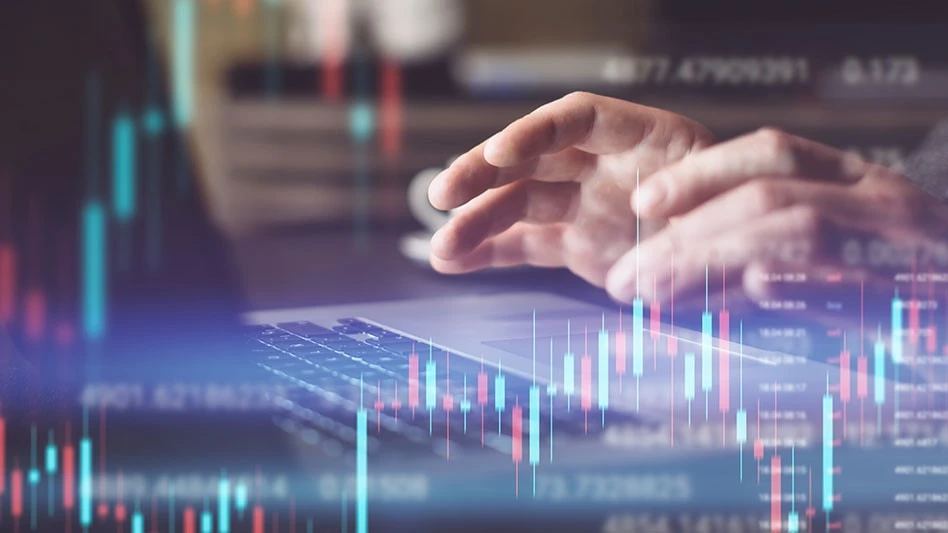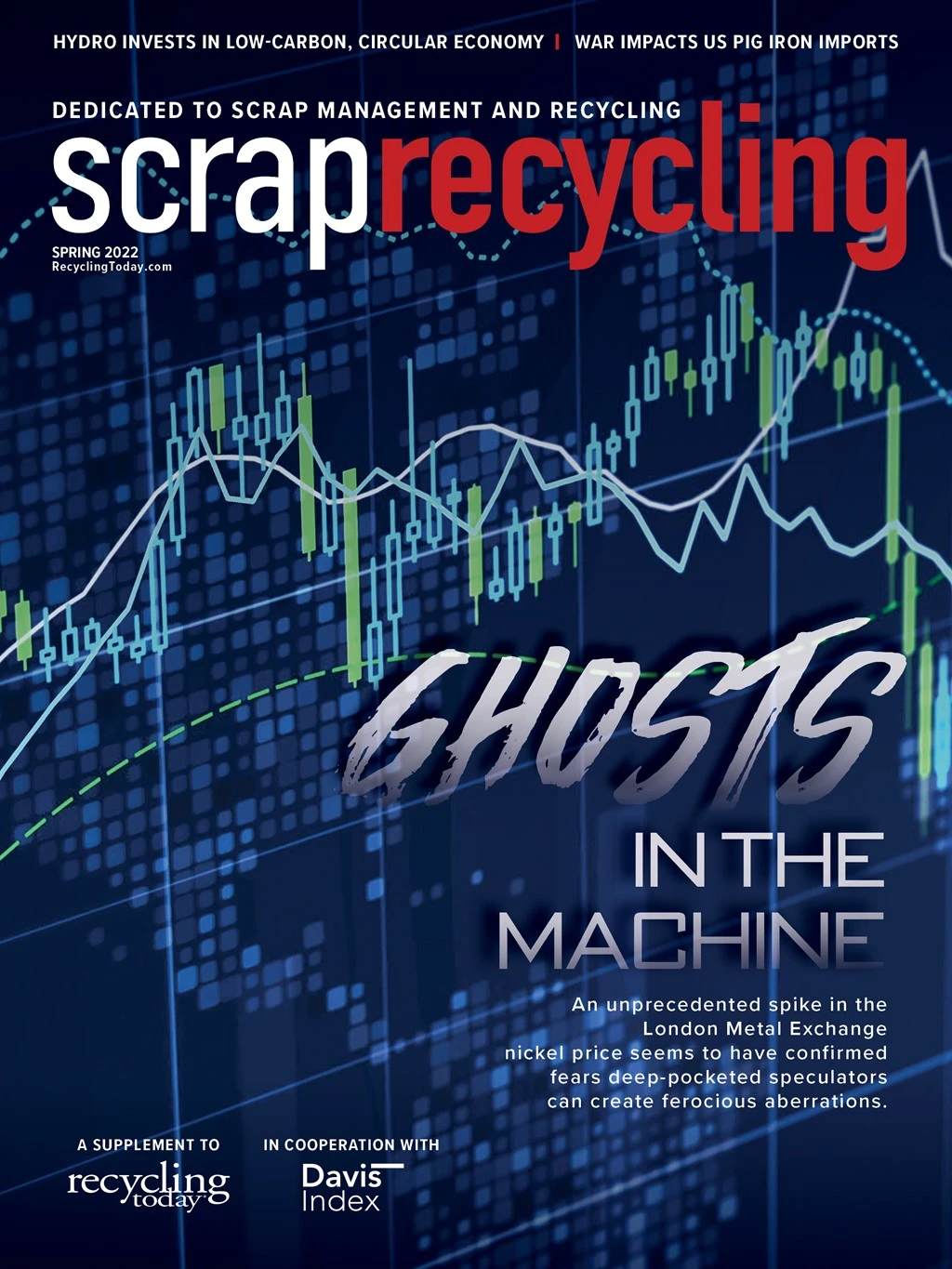
Rymden | stock.adobe.com

More than 10 years ago, at a 2011 Non-ferrous Division meeting of the Bureau of International Recycling (BIR), a United States-based scrap trader referred to “ghosts that haunt and influence our daily business.”
Glen Gross, then with Pittsburgh-based Wimco Metals, was referring to fund investors in the copper market as managing “unseen financial flows that regularly rocket and torpedo our markets.” He continued, “Today, because of these ghosts, I find that markets act the opposite of what our brains tell us. Managing risk seems to consume an inordinate amount of our time and has created the most challenges.”
Those challenges—and seemingly the ghosts who help create them—reached an unprecedented scale this March when the price of nickel on the London Metal Exchange (LME) soared skyward and caused trading on the nickel contract to be suspended for more than a week.
A spark and then a fire
When intelligence agencies sent out warnings in early 2022 that Russia was preparing to invade Ukraine, the anticipated effect on global supplies of oil, natural gas, steel, stainless steel and aluminum already was roiling commodity markets. When the invasion occurred Feb. 24, the turbulence increased.
While numerous metals experienced pricing volatility, what happened with nickel (a critical alloy in stainless steel and key ingredient in many electric vehicle, or EV, batteries) in early and mid-March represented a phenomenon unto itself.
The predominant venue through which nickel is warehoused, traded and hedged is the LME. “Whilst there may be other indices in trade publications for scrap or primary nickel, as far as I know there are no other markets where you can offset or hedge a physical price risk for nickel,” says one Asia-based scrap trader. “For the trade, there is no current alternative market where price risk can be offset.”
However, the LME nickel market itself came to a grinding halt in March. “While in the previous seven years the nickel market had risen by $10,000, Monday, March 7, it rose by $21,000 from $29,000 to $50,000 in one day—far beyond the expectation of any risk methodology,” writes Shanghai-based commodities trader John Browning of BANDS Financial in an April 1 email to clients.
“As the market catapulted to over $100,000 on Tuesday morning [March 8], it would be safe to assume a number of LME brokerage companies were heading toward bankruptcy if unable to cover client losses,” Browning adds.
Reporting by Bloomberg revealed that numerous companies held sizable positions on the price of nickel moving in one direction or the other as the unprecedented 250 percent price spike was underway. Although traders typically enjoy anonymity in the market, Bloomberg discovered and disclosed the names of numerous parties involved.
Shorting the price of nickel was Asia’s largest stainless steel producer Tsingshan Holding Group Co., based in Wenzhou City, China. Bloomberg says the company’s LME nickel short position “was unusually large, equivalent at its peak to roughly 1 in 8 of all the contracts outstanding in the LME nickel contract.”
Taking the other position were some physical nickel traders, including automaker Volkswagen and Switzerland- based commodities firm Glencore. They were joined by hedge funds and banking firms, including JP Morgan Chase, New York; BNP Paribas, France; and Standard Chartered Bank, London, according to Bloomberg. These players now are being characterized in some media accounts as “squeezing” Tsingshan to pay costly margin calls.
Some of this Bloomberg information was published (initially and briefly) on its website early March 8 as the LME resumed trading, Browning says. That helped create conditions where the nickel “market simply convulsed to $113,000 per ton,” he writes.
That convulsion prompted what would be an eight-day halt to nickel trading on the LME. “Perhaps the biggest controversy surrounding the price action of nickel was the cancellation of the seven hours of trading executed on the morning of Tuesday, March 8, variously reported as worth $3 billion to $4 billion,” Browning adds.
The wild ride was about more than bank balance sheets and notional trade positions. It also seized up the physical buying and selling of stainless steel scrap and other nickel-bearing scrap that is consumed worldwide.

Price nondiscovery
From the scale house of the most modest scrap yard to the largest stainless steel melt shop, a reference point for the 18 percent or so of nickel that characterizes stainless alloys helps the supply chain feel a sense of price transparency.
When the LME nickel price was first extraordinarily volatile and then completely unavailable, it put a halt to many transactions in the U.S. and elsewhere.
“Many market participants had enormous difficulties pricing their products correctly in the market,” says Murat Bayram, who works from Germany for U.K.-based company EMR Ltd. “Starting with demolition companies, which, for example, dismantle factories based on stainless steel prices and offset the proceeds from the metals, through to metal [exporting],” much buying and selling was put on hold, he adds.
In the United States, Kentucky-based North American Stainless (NAS), as of early April, still was hosting a message on its website about surcharges tied to the LME volatility. That message reads in part, “North American Stainless is going to define the nickel portion of the April 2022 surcharge using only official closing prices from Feb. 21st through March 18. The days of trading that included ‘disruption events’ and days in which the LME were closed will not be used in the calculation of the LME nickel average for the pricing period.”
NAS, which is among the largest stainless scrap consuming melt shops in the U.S., says its surcharge will be based on “the value [of nickel] the period from Feb. 21 to March 18 [as] $12.60 per pound, or $27,777.88 per metric ton.”
While that is a high price compared with 2021 and earlier, it represents a way forward after the earlier uncertainty.
“For several days, the players in the field of recycling had to help themselves and analyze supply and demand in the field of stainless steel and other nickel alloys through a lot of their own research,” Bayram says. “We all agree that this was not an optimal situation.”
The emerging lithium-ion and EV battery recycling market was another victim of the LME uncertainty. A buyer of “black mass” resulting from shredded lithium-ion batteries tells RecyclingToday that in March neither buyers nor sellers knew how to price the product, which typically contains approximately 15 percent nickel oxide.
Traders Recycling Today contacted are unanimous in saying they want and need the LME to move forward after having learned a difficult lesson. Foremost among those voices is industry veteran Michael Lion, himself a former LME ring trader. Lion also currently chairs the International Trade Committee of Brussels-based BIR.
“It’s not a sentimental view I’m holding,” Lion says. “LME bashing is not helpful. We have to find ways of making it sustainable, otherwise we’ll have complete anarchy.”
“LME bashing is not helpful. We have to find ways of making it sustainable, otherwise we’ll have complete anarchy.” – Michael Lion, BIR International Trade Committee
Forward, after March
One way to stem extreme volatility in commodities trading is to place “market up” and “market down” daily limits on price movement. It is not a technique favored by all traders, but such a policy likely would have stemmed some of the worst impacts of the March LME nickel contract fiasco.
Lion says the oft-used Chicago-based COMEX copper contract has long had these limits or “freeze parameters.” He says, “The good side is you avoid the situation that just happened with nickel. The bad side is traders can get locked into positions for days on end with a minimal ability to get out of their positions. I’ve seen that happen in the past, and it can be quite hellacious.”
The role of banks and hedge funds—as noted by Gross in 2011—has received scrutiny, but Lion tempers his criticism with pointing out the necessary counter-party role they play. He adds, though, that the Hong Kong Exchange (HKEX), which purchased the LME in 2012, might have opened the door too wide to such players.
“To profit from this investment, HKEX had to find ways of increasing their revenue,” Lion says. “They looked to bring in greater volume, which can only come by encouraging the engagement of nontrade players, such as financial institutions and hedge funds.” (Of the latter, Lion quips, the name is “a misnomer if I’ve ever heard one.”)
He continues, “Those parties are speculators, and some of those are needed to provide equal and opposite liquidity. But, it becomes a problem when it becomes disproportionate. This is what has happened with HKEX courting these players—a Faustian pact one might say.”
Faust’s devil showed up in early March when, as Lion describes it, “a massive weight of money from the nontrade sector, exacerbated by algorithms, created the soaring nickel price situation.”
Lion, in speaking to Recycling Today and in LinkedIn posts he made in March and April, defends the LME overall. Pointing to what he considers off-target criticism in the media, Lion has written on LinkedIn that some media coverage “continues to focus on the errors and even questioning the justification for survival of the LME.”
The veteran trader calls much of this coverage “frankly ill-informed, often based on false and or misleading premises [and] negative, even clickbait yellow-press crassness.”
Investigations into what occurred now are underway by regulatory and monetary authorities, and multiple legal discovery processes have no doubt started as banks and funds that stood to profit from canceled LME trades seek legal recourse. These efforts, in turn, will yield procedural changes.
Bayram is among those who say they expect a stronger LME to emerge as a result of this recent crisis. “The LME has held its own in past crises and means a lot for our industry,” he says. “Even if there are investigations now, I see it as a positive thing because you can only learn from mistakes.”
The Asia-based trader says, “Large-scale, extreme manipulation of the market is not healthy for the physical metals industry. As far as I understand it, the LME did not in any way breach its own internal rules in taking the action to step in when it did.” He concludes, “I see the LME’s actions as unavoidable in those particular circumstances.”
In reviewing the entire affair and the roles of those involved, BANDS Financial’s Browning attempts to channel the thoughts of deceased former LME regulation and compliance executive Alan Whiting. “I ask myself a simple question,” Browning writes April 1. “What would Alan say? And, I think I know the answer: He would say, ‘Fools. The whole lot of them.’”

Explore the Spring 2022 Scrap Recycling Issue
Check out more from this issue and find your next story to read.
Latest from Recycling Today
- BMW Group, Encory launch 'direct recycling’ of batteries
- Loom Carbon, RTI International partner to scale textile recycling technology
- Goodwill Industries of West Michigan, American Glass Mosaics partner to divert glass from landfill
- CARI forms federal advocacy partnership
- Monthly packaging papers shipments down in November
- STEEL Act aims to enhance trade enforcement to prevent dumping of steel in the US
- San Francisco schools introduce compostable lunch trays
- Aduro graduates from Shell GameChanger program





